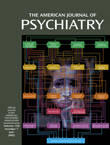Brain-to-Serum Lithium Ratio and Age: An In Vivo Magnetic Resonance Spectroscopy Study
Abstract
OBJECTIVE: The authors’ goal was to determine if there is an association between brain-to-serum lithium ratios and age. METHOD: Lithium-7 magnetic resonance spectroscopy was used to measure in vivo brain lithium levels in nine children and adolescents (mean age=13.4 years, SD=3.6) and 18 adults (mean age=37.3, SD=9.1) with bipolar disorder. RESULTS: Serum and brain lithium concentrations were positively correlated. Younger subjects had lower brain-to-serum concentration ratios than adults: 0.58 (SD=0.24) versus 0.92 (SD=0.36). The brain-to-serum concentration ratio correlated positively with age. CONCLUSIONS: These observations suggest that children and adolescents may need higher maintenance serum lithium concentrations than adults to ensure that brain lithium concentrations reach therapeutic levels.



